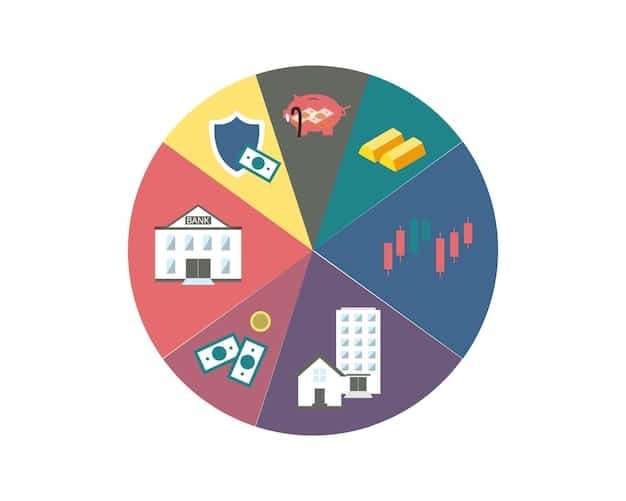Maximize Your 401(k) in 2025: New Contribution Limits & Tax Guide

Maximize your 401(k) in 2025 by understanding new contribution limits, catch-up provisions, and tax advantages to secure a financially sound retirement.
Are you ready to supercharge your retirement savings? Knowing how to maximize your 401(k) in 2025, with its new contribution limits and tax advantages, is crucial for a comfortable and secure future. This guide will walk you through everything you need to know.
Understanding 401(k) Basics
A 401(k) is a retirement savings plan sponsored by an employer. It allows employees to save and invest a portion of their paycheck before taxes are taken out. Understanding the fundamentals of a 401(k) is the first step toward maximizing its benefits for your retirement.
What is a 401(k)?
A 401(k) plan enables you to contribute a percentage of your salary, which is then invested in various assets such as stocks, bonds, and mutual funds. The earnings grow tax-deferred, meaning you won’t pay taxes until you withdraw the money in retirement.
Types of 401(k) Plans
There are generally two types of 401(k) plans: traditional and Roth. With a traditional 401(k), contributions are made pre-tax, reducing your current taxable income. With a Roth 401(k), contributions are made after-tax, but withdrawals in retirement are tax-free.
- Traditional 401(k): Pre-tax contributions, tax-deferred growth, taxed withdrawals in retirement.
- Roth 401(k): After-tax contributions, tax-free growth, tax-free withdrawals in retirement.
- Employer Matching: Many employers offer to match a portion of your contributions, essentially free money towards your retirement.
Understanding these basics is crucial as you plan to maximize your 401(k) contributions and take full advantage of available benefits. Make sure to review your employer’s plan details to know which options are available to you.

New 401(k) Contribution Limits for 2025
Staying informed about the latest 401(k) contribution limits is vital for optimizing your retirement savings. The IRS adjusts these limits annually to account for inflation, potentially allowing you to save more. Let’s look at what you can expect for 2025.
Employee Contribution Limit
Each year, the IRS sets a limit on how much employees can contribute to their 401(k) accounts. These limits can change annually, so staying updated is crucial. The employee contribution limit refers to the maximum amount an individual can contribute from their salary.
Catch-Up Contribution for Those 50 and Over
For those aged 50 and older, the IRS also sets a catch-up contribution limit. This allows older workers to contribute even more to their 401(k)s, providing an opportunity to boost their retirement savings as they approach retirement age.
- Increase Savings: Catch-up contributions help those nearing retirement save more quickly.
- Stay Updated: Ensure you know the specific catch-up limit for 2025, as it can change yearly.
- Plan Accordingly: Adjust your contribution strategy to maximize this extra savings opportunity.
Understanding these contribution limits and planning your savings accordingly are essential steps in maximizing your 401(k) for a secure retirement. Watch for the official IRS announcements to confirm the exact figures for 2025.
Tax Advantages of Contributing to a 401(k)
One of the biggest draws of a 401(k) is its tax advantages, which can significantly boost your savings over time. Understanding these benefits can help you make informed decisions and maximize your retirement funds.
Pre-Tax Contributions
With a traditional 401(k), your contributions are made before taxes are deducted from your paycheck, reducing your current taxable income. This can result in immediate tax savings.
Tax-Deferred Growth
The money in your 401(k) grows tax-deferred, meaning you only pay taxes when you withdraw the funds in retirement. This allows your investments to compound more quickly, as you’re not losing money to taxes each year.
Roth 401(k) Benefits
While Roth 401(k) contributions are made after-tax, they offer a different advantage: tax-free withdrawals in retirement. This can be particularly beneficial if you anticipate being in a higher tax bracket in retirement.
The tax advantages of a 401(k) can provide significant benefits, helping your savings grow faster and more efficiently. Evaluate both the traditional and Roth options to determine which best suits your financial situation and long-term goals. Tax laws are subject to change, so staying informed is key.
Strategies to Maximize Your 401(k)
Maximizing your 401(k) involves more than just knowing the contribution limits. Strategic planning and smart investment choices can make a big difference in the long run. Here are some strategies to help you get the most out of your 401(k).
Contribute Enough to Get the Full Employer Match
If your employer offers to match a portion of your 401(k) contributions, make sure you contribute enough to take full advantage of this match. It’s essentially free money that can significantly boost your retirement savings.
Increase Contributions Gradually
If you can’t max out your 401(k) right away, consider increasing your contributions gradually over time. Even small increases can have a big impact, and you may hardly notice the difference in your take-home pay.
- Start Small: Begin by increasing your contribution by 1% each year.
- Automate: Set up automatic increases to stay on track.
- Reassess Annually: Review your budget each year to see if you can increase your contribution further.

Choose the Right Investments
Your 401(k)’s investment options will impact your returns. Consider diversifying your investments to reduce risk. Target-date funds are a popular choice, as they automatically adjust your asset allocation as you get closer to retirement.
Using these strategies can dramatically improve your 401(k)’s performance and help you reach your retirement goals faster. Regular reviews and adjustments are essential to stay on track and adapt to changing circumstances.
Common 401(k) Mistakes to Avoid
Avoiding common 401(k) mistakes can save you money and ensure you’re on the right path to a secure retirement. Many people unknowingly make errors that can negatively impact their savings.
Cashing Out Early
One of the biggest mistakes is cashing out your 401(k) early. Not only will you face taxes on the withdrawn amount, but you’ll also likely incur a 10% penalty if you’re under age 59 ½. This can significantly diminish your retirement savings.
Not Rebalancing Your Portfolio
Over time, your investment allocations can drift away from your original plan. Regularly rebalancing your portfolio ensures you maintain the desired level of risk and return.
Ignoring Fees
Pay attention to the fees associated with your 401(k), such as management fees and administrative costs. High fees can eat into your returns over time.
Resources for Further Learning
To further enhance your understanding and effectiveness in maximizing your 401(k), it is helpful to utilize various reliable resources that offer assistance and education.
IRS Website
The IRS website (irs.gov) offers a comprehensive range of information on retirement plans, including 401(k) contribution limits, tax implications, and regulatory updates.
Financial Advisors
If you have access to a financial advisor, they can help you to create a customized 401(k) plan based on your specific needs. They can also help you to stay on top of things that you might forget.
Employer provided resources
Be sure to thoroughly read the materials provided by your employer and don’t hesitate to contact them with any questions you may have regarding maximizing your 401(k). Your human resource department is there as a resource for you.
| Key Point | Brief Description |
|---|---|
| 💰 Contribution Limits | Stay updated on the 2025 limits to maximize pre-tax or Roth contributions. |
| 🎁 Employer Match | Contribute enough to receive the full employer match, boosting your savings. |
| 📈 Investment Choices | Diversify investments and consider target-date funds for automatic adjustments. |
| 🎂 Catch-Up Contributions | If you’re 50+, take advantage of higher contribution limits to catch up. |
Frequently Asked Questions (FAQ)
▼
The employee contribution limit for 2025 has not yet been officially announced. However, this guide will be updated once it is to reflect the current limit. Always confirm with the IRS (irs.gov).
▼
A catch-up contribution is an additional amount that individuals aged 50 and over can contribute to their 401(k) beyond the regular annual limit. This is to assist in saving for retirement.
▼
A traditional 401(k) takes contributions pre-tax, withdrawals are then taxed in retirement. A Roth 401(k) does the opposite- contributions are taxed and withdrawals in retirement are tax-free.
▼
Most 401(k) plans allow you to change your elections once a quarter, but some may allow more frequent changes. Review your plan’s rules to see what elections you have access to when planning.
▼
Target-date funds are diversified investment funds that automatically adjust their asset allocation over time, becoming more conservative as you approach your retirement date. This is considered a more hands-off investment.
Conclusion
Maximizing your 401(k) in 2025 involves understanding the new contribution limits, leveraging tax advantages, and implementing effective strategies. By staying informed and making smart choices, you can secure a financially sound retirement.





